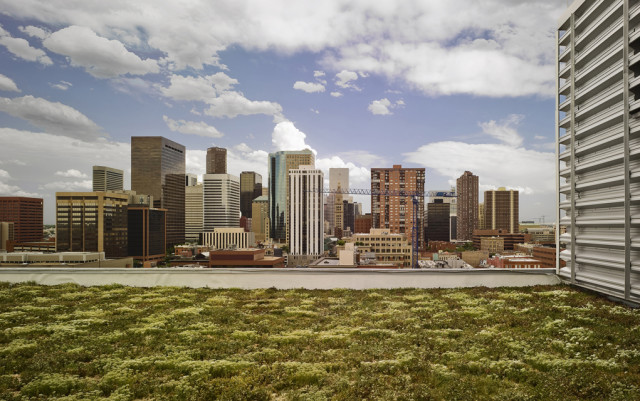
Though it’s winter right now along the Front Range, the city of Denver sits pleasantly above 50 degrees most days. Sure, it’s nice to have warm weather this time of year, but the city’s warmth can be attributed to the urban heat island (UHI) effect. Denver has one of the most intense UHI effects in the nation, which makes summers unbearably hot and keeps the city unseasonably warm during the winter.
Thomas Slabe, biologist at the Environmental Protection Agency’s office in Denver, sees the importance of cooling down the city.
“It’s going to be increasingly important in a lot of cities because heat waves are going to potentially get more severe, and heat-related illnesses are the number one killer of people from natural disasters, more than all the others combined,” Slabe says.
To combat this, there are many greening and cooling initiatives taking over cities nationwide. In Denver, the Mile High Million has planted 2.2 million trees. The Mile High Million was originally part of then-Mayor John Hickenlooper’s Greenprint Denver citywide sustainability initiative in 2006. Since then it has transformed under Mayor Michael Hancock into an initiative to care for Denver’s existing trees. Trees are an important first step toward cooling the city, as they retain moisture that will evaporate when it’s hot, cooling the air as it does. In urban environments, the trade of trees and soil for concrete and metal means less moisture is held within the city, so it is less capable of cooling itself, similar to a person who has lost their ability to sweat.
Despite its vicinity fairly close to Denver, there is plenty of open space in Boulder that allows it to cool off faster. With the amount of open space and Boulder County constantly trying to buy more, the possibility of Boulder becoming a future heat island is less likely. However, if the suburbs along U.S. 36 keep growing, converting undeveloped areas, Boulder will face similar problems.
As Denver continues to plant trees, citizens should look to other strategies that could be incorporated into the city’s plan. In October 2008, the EPA released its Heat Island Compendium suggesting alternatives for cooling down cities. Along with planting trees, creating parks and vegetating roofs are the way to go for Denver.
Green roofs, like what is in place at the EPA’s regional office in Denver, can help cool all city buildings. They use soil, grass and plants to create a layer between the roof and atmosphere to buffer it from the elements and provide shade, a natural cooling agent. With the addition of plants and dirt, green roofs also retain more water, allowing evaporation to cool the air further. Plus, they work as insulators, keeping building temperatures more pleasant and requiring less energy to heat or cool the building.
Dr. Gordon Bonan, a senior scientist with the National Center for Atmospheric Research’s Global Dynamics Lab in Boulder, believes making Denver greener is the way to go.
“Instead of using white roofs, which is the other main technique, planting trees and making parks and green roofs works best for a dry place like Denver,” he says.
As the summertime heat grows, cities built of metal and concrete and lacking in trees become hotter compared to undeveloped environments around them. Many issues can result, including an increase in energy use, a decrease in water quality and a rise in heat-related health issues. Summertime heat is most affected by surface UHI, which is most intense during summer days and can make city surface temperatures 18-27 degrees hotter than nearby rural areas.
“When there isn’t much moisture in the atmosphere, evapotranspiration (the movement of water from the surface to the atmosphere) has a larger effect than somewhere like Florida,” Bonan says. “It’s amazing what a park simply can do. Even if it’s surrounded by buildings, a park can make the atmosphere a lot cooler. And you can feel the difference when you’re there.”
The spring snowmelt is very important to keeping Denver cool, but concrete streets speed up and move water out of the city. The EPA suggests cities restructure their right of ways, the area between the edge of the road and the end of the sidewalk, to capture water and grow plants. This keeps the water within the city, so it can evaporate when it gets hot and cool the air.
Keeping the streets of Denver cool is important for the health of its citizens, and the best way to do so is keeping moisture within the city. Though there’s a lot of technology available for this purpose, it seems old school shrubbery is the answer.














